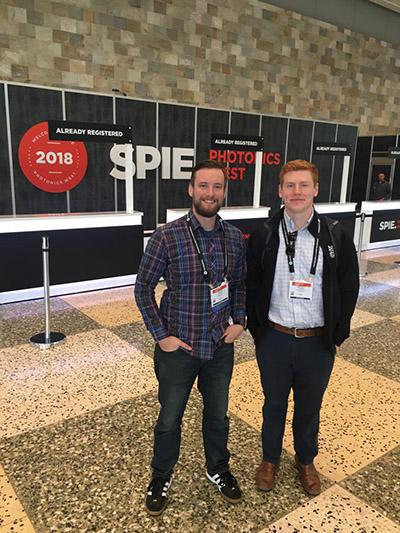
Two graduate students in Duke neurosurgeon Patrick Codd’s lab each had independent conference papers accepted for oral presentations at the International Society for Optics and Photonics meeting in San Francisco, January 27-February 1, 2018. SPIE Photonics West is the world's largest biomedical, optics, and laser conference.
Weston Ross presented his work on machine learning algorithms he is developing to guide automated laser resection of tissue. The ultimate goal is using these to allow a robot to autonomously resect tumor tissue with maximal safety and accuracy. This work was done in collaboration with Professor Brian Mann of the Department of Mechanical Engineering and Materials Science.
Matthew Tucker presented his work on creation of a novel gel brain phantom with precisely tunable optical properties that mimic the changes in photochemical signal in both normal and cancerous tissues. By creating this brain mimic on the benchtop, it allows repeated tests of robotic platforms in an ex vivo manner in order to minimize the animal tissue needed. This work was done in collaboration with Professor Tuan Vo-Dinh's group in the Duke Fitzpatrick Institute of Photonics.
Optimized path planning for soft tissue resection via laser vaporization, Weston Ross, Duke Univ. (USA); Neil Cornwell, North Carolina State Univ. (USA); Sreekar Mantena, North Carolina School of Science and Mathematics (USA); Matthew Tucker, Brian Mann, Patrick Codd M.D., Duke Univ. (USA)
Creation of an optically tunable, solid tissue phantom for use in cancer detection, Matthew Tucker, Duke Univ. (USA); Catherine Wallace, Medical College of Georgia (USA); Sreekar Mantena, North Carolina School of Science and Mathematics (USA); Neil Cornwell, North Carolina State Univ. (USA); Weston Ross, Ren Odion, Tuan Vo-Dinh, Patrick Codd, Duke Univ. (USA)